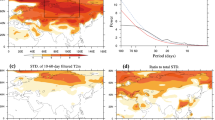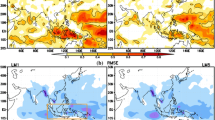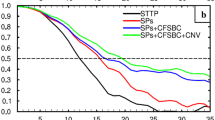Abstract
Eastward propagating Madden–Julian Oscillation (MJO) is a dominant mode of the intraseasonal variability and hence a potential source of intraseasonal predictability. Therefore, advancing MJO prediction using state-of-the-art dynamical model is of utmost importance for improving intraseasonal prediction. The prediction skill and predictability of MJO are assessed using 44 members ensemble hindcast (16 years data; 2001–2016) of CFSv2 based extended range prediction (ERP) system of IITM as well as 10 member ensemble hindcast (16 years data; 2001–2016) of ECMWF S2S dataset. The MJO is diagnosed using a newly developed Extended Empirical Orthogonal Function (EEOF) analysis. Near equatorial (15° S–15° N) model anomaly fields are projected onto the leading pair of observed eigen modes. The leading pair of observed eigen modes are obtained based on the EEOF analysis of the combined field of zonal wind at 200 hPa (U200), zonal wind at 850 hPa (U850) and velocity potential at 200 hPa (chi200). Model forecasted principal components (PCs) are quantitatively compared with observed PCs using bivariate correlation coefficient and root mean square error (RMSE). We find that MJO could be predicted up to around 22 days (around 31 days) for IITM ERP system (ECMWF S2S dataset) as measured by anomaly correlation coefficient remains larger than 0.5 and RMSE remains lower than 1.4. This prediction skill is quite low compared to potential predictability, which is estimated as more than 40 days both for IITM-ERP and ECMWF system. MJO prediction skill varies with initial MJO phase, particularly at the longer lead. This variation is more significant for the ECMWF system. Model (both for IITM-ERP and ECMWF) predicted amplitude drops at a faster rate and phase propagation speed for almost all initial phase is slower and amplitude is weaker compared to the observation. It could be concluded that even the state-of-the-art models [IITM-ERP (basically NCEP CFSv2) and ECMWF] are also not free from systematic errors/biases. Hence, there is an enormous space for improving MJO prediction skill by reducing these errors/biases in the dynamical model and error in the initial condition.








Similar content being viewed by others
References
Abhilash, S., Sahai, A. K., Borah, N., et al. (2014a). Prediction and monitoring of monsoon intraseasonal oscillations over Indian monsoon region in an ensemble prediction system using CFSv2. Climate Dynamics, 42, 2801–2815. https://doi.org/10.1007/s00382-013-2045-9.
Abhilash, S., Sahai, A. K., Pattnaik, S., & De, S. (2013). Predictability during active break phases of Indian summer monsoon in an ensemble prediction system using climate forecast system. The Journal of Atmospheric and Solar-Terrestrial Physics, 100–101, 13–23. https://doi.org/10.1016/j.jastp.2013.03.017.
Abhilash, S., Sahai, A. K., Pattnaik, S., et al. (2014b). Extended range prediction of active-break spells of Indian summer monsoon rainfall using an ensemble prediction system in NCEP Climate Forecast System. International Journal of Climatology, 34, 98–113. https://doi.org/10.1002/joc.3668.
Bhatla, R., Singh, M., & Pattanaik, D. R. (2017). Impact of Madden–Julian Oscillation on onset of summer monsoon over India. Theoretical and Applied Climatology, 128, 381–391. https://doi.org/10.1007/s00704-015-1715-4.
Dey, A., Chattopadhyay, R., Sahai, A. K., et al. (2019). An operational tracking method for the MJO using extended empirical orthogonal functions. Pure and Applied Geophysics, 176, 2697–2717. https://doi.org/10.1007/s00024-018-2066-8.
Fu, X., Wang, B., Lee, J.-Y., et al. (2011). Sensitivity of dynamical intraseasonal prediction skills to different initial conditions. Monthly Weather Review, 139, 2572–2592. https://doi.org/10.1175/2011MWR3584.1.
Griffies, S. M., Harrison, M. J., Pacanowski, R. C., & Rosati, A. (2004). A technical guide to MOM4, GFDL Ocean Group Technical report 5. Princeton, NJ: NOAA/Geophysical Fluid Dynamics Laboratory.
Hendon, H. H., & Salby, M. L. (1994). The life cycle of the Madden–Julian Oscillation. Journal of the Atmospheric Sciences, 51, 2225–2237. https://doi.org/10.1175/1520-0469(1994)051%3c2225:TLCOTM%3e2.0.CO;2.
Hung, M.-P., Lin, J.-L., Wang, W., et al. (2013). MJO and convectively coupled equatorial waves simulated by CMIP5 climate models. Journal of Climate, 26, 6185–6214. https://doi.org/10.1175/JCLI-D-12-00541.1.
Jiang, X., Waliser, D. E., Wheeler, M. C., et al. (2008). Assessing the skill of an all-season statistical forecast model for the Madden–Julian Oscillation. Monthly Weather Review, 136, 1940–1956. https://doi.org/10.1175/2007MWR2305.1.
Kalnay, E., Kanamitsu, M., Kistler, R., et al. (1996). The NCEP/NCAR 40-year reanalysis project. Bulletin of the American Meteorological Society, 77, 437–471. https://doi.org/10.1175/1520-0477(1996)077%3c0437:TNYRP%3e2.0.CO;2.
Kikuchi, K., Wang, B., & Kajikawa, Y. (2012). Bimodal representation of the tropical intraseasonal oscillation. Climate Dynamics, 38, 1989–2000. https://doi.org/10.1007/s00382-011-1159-1.
Kiladis, G. N., Dias, J., Straub, K. H., et al. (2014). A comparison of OLR and circulation-based indices for tracking the MJO. Monthly Weather Review, 142, 1697–1715. https://doi.org/10.1175/MWR-D-13-00301.1.
Kim, H.-M., Kim, D., Vitart, F., et al. (2016). MJO propagation across the maritime continent in the ECMWF ensemble prediction system. Journal of Climate, 29, 3973–3988. https://doi.org/10.1175/JCLI-D-15-0862.1.
Kim, H.-M., Webster, P. J., Toma, V. E., & Kim, D. (2014). Predictability and prediction skill of the MJO in two operational forecasting systems. Journal of Climate, 27, 5364–5378. https://doi.org/10.1175/JCLI-D-13-00480.1.
Lau, K.-M., & Chan, P. H. (1986). Aspects of the 40–50 day oscillation during the northern summer as inferred from outgoing longwave radiation. Monthly Weather Review, 114, 1354–1367. https://doi.org/10.1175/1520-0493(1986)114%3c1354:AOTDOD%3e2.0.CO;2.
Lin, H., Brunet, G., & Derome, J. (2008). Forecast skill of the Madden–Julian Oscillation in two Canadian atmospheric models. Monthly Weather Review, 136, 4130–4149. https://doi.org/10.1175/2008MWR2459.1.
Madden, R. A., & Julian, P. R. (1972). Description of global-scale circulation cells in the tropics with a 40–50 day period. J Atmospheric Sci, 29, 1109–1123. https://doi.org/10.1175/1520-0469(1972)029%3c1109:DOGSCC%3e2.0.CO;2.
Madden, R. A., & Julian, P. R. (1994). Observations of the 40–50-day tropical oscillation—a review. Monthly Weather Review, 122, 814–837. https://doi.org/10.1175/1520-0493(1994)122%3c0814:OOTDTO%3e2.0.CO;2.
Neena, J. M., Lee, J. Y., Waliser, D., et al. (2014). Predictability of the Madden–Julian Oscillation in the intraseasonal variability hindcast experiment (ISVHE). Journal of Climate, 27, 4531–4543. https://doi.org/10.1175/JCLI-D-13-00624.1.
Pai, D. S., Bhate, J., Sreejith, O. P., & Hatwar, H. R. (2011). Impact of MJO on the intraseasonal variation of summer monsoon rainfall over India. Climate Dynamics, 36, 41–55. https://doi.org/10.1007/s00382-009-0634-4.
Rashid, H. A., Hendon, H. H., Wheeler, M. C., & Alves, O. (2011). Prediction of the Madden–Julian Oscillation with the POAMA dynamical prediction system. Climate Dynamics, 36, 649–661. https://doi.org/10.1007/s00382-010-0754-x.
Reichler, T., & Roads, J. O. (2005). Long-range predictability in the tropics. Part II: 30–60-day variability. Journal of Climate, 18, 634–650. https://doi.org/10.1175/JCLI-3295.1.
Saha, S., Moorthi, S., Wu, X., et al. (2013). The NCEP climate forecast system version 2. Journal of Climate, 27, 2185–2208. https://doi.org/10.1175/JCLI-D-12-00823.1.
Salby, M. L., & Hendon, H. H. (1994). Intraseasonal behavior of clouds, temperature, and motion in the tropics. J Atmospheric Sci, 51, 2207–2224. https://doi.org/10.1175/1520-0469(1994)051%3c2207:IBOCTA%3e2.0.CO;2.
Seo, K.-H., Wang, W., Gottschalck, J., et al. (2009). Evaluation of MJO forecast skill from several statistical and dynamical forecast models. Journal of Climate, 22, 2372–2388. https://doi.org/10.1175/2008JCLI2421.1.
Singh, M., & Bhatla, R. (2018). Role of Madden–Julian Oscillation in modulating monsoon retreat. Pure and Applied Geophysics, 175, 2341–2350. https://doi.org/10.1007/s00024-018-1788-y.
Singh, M., & Bhatla, R. (2019). Modulation of active-break spell of Indian summer monsoon by Madden Julian oscillation. Journal of Earth System Science, 128, 70. https://doi.org/10.1007/s12040-019-1091-z.
Singh, M., Bhatla, R., & Pattanaik, D. R. (2017). An apparent relationship between Madden–Julian Oscillation and the advance of Indian summer monsoon. International Journal of Climatology, 37, 1951–1960. https://doi.org/10.1002/joc.4825.
Ventrice, M. J., Wheeler, M. C., Hendon, H. H., et al. (2013). A modified multivariate Madden–Julian oscillation index using velocity potential. Monthly Weather Review, 141, 4197–4210. https://doi.org/10.1175/MWR-D-12-00327.1.
Vitart, F. (2014). Evolution of ECMWF sub-seasonal forecast skill scores. Quarterly Journal Royal Meteorological Society, 140, 1889–1899. https://doi.org/10.1002/qj.2256.
Vitart, F. (2017). Madden—Julian Oscillation prediction and teleconnections in the S2S database. Quarterly Journal Royal Meteorological Society, 143, 2210–2220. https://doi.org/10.1002/qj.3079.
Vitart, F., Woolnough, S., Balmaseda, M. A., & Tompkins, A. M. (2007). Monthly forecast of the Madden–Julian Oscillation using a coupled GCM. Monthly Weather Review, 135, 2700–2715. https://doi.org/10.1175/MWR3415.1.
Waliser, D. E., Lau, K. M., Stern, W., & Jones, C. (2003). Potential predictability of the Madden–Julian Oscillation. Bulletin of the American Meteorological Society, 84, 33–50. https://doi.org/10.1175/BAMS-84-1-33.
Wang, W., Hung, M.-P., Weaver, S. J., et al. (2014). MJO prediction in the NCEP climate forecast system version 2. Climate Dynamics, 42, 2509–2520. https://doi.org/10.1007/s00382-013-1806-9.
Wheeler, M. C., & Hendon, H. H. (2004). An all-season real-time multivariate MJO index: development of an index for monitoring and prediction. Monthly Weather Review, 132, 1917–1932. https://doi.org/10.1175/1520-0493(2004)132%3c1917:AARMMI%3e2.0.CO;2.
Acknowledgements
We thank the Ministry of Earth Sciences (MoES), Govt. of India, for the complete support of the research work carried out at the Indian Institute of Tropical Meteorology. We also express our sincere thanks to NCEP–NCAR and ECMWF for providing data. We have used GrADS, NCAR command language (NCL) and Xmgrace for plotting figures/graphs. We express sincere gratitude to the developers for making software packages freely available. Model runs are carried out on the “Aaditya” high performance computing system installed at IITM, Pune. The authors are grateful to the anonymous reviewers for their constructive comments which improved the manuscript.
Author information
Authors and Affiliations
Corresponding author
Additional information
Publisher's Note
Springer Nature remains neutral with regard to jurisdictional claims in published maps and institutional affiliations.
Rights and permissions
About this article
Cite this article
Dey, A., Chattopadhyay, R., Sahai, A.K. et al. MJO Prediction Skill Using IITM Extended Range Prediction System and Comparison with ECMWF S2S. Pure Appl. Geophys. 177, 5067–5079 (2020). https://doi.org/10.1007/s00024-020-02487-z
Received:
Revised:
Accepted:
Published:
Issue Date:
DOI: https://doi.org/10.1007/s00024-020-02487-z




